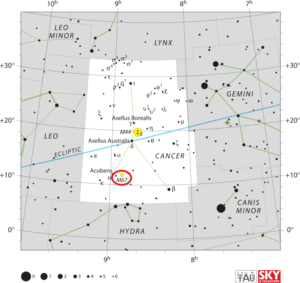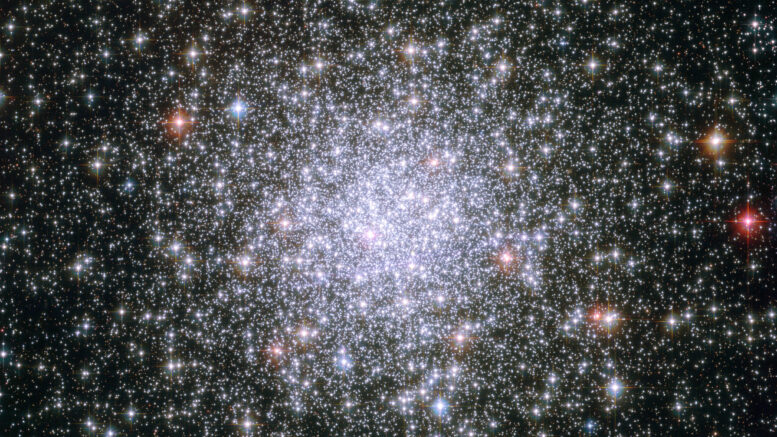Messier 69 is a globular star cluster located in the southern constellation Sagittarius. M69 is one of the most metal-rich globular clusters ever observed, which is heavier than hydrogen and helium. The stars in M69 have over ten times more iron than stars in other globular clusters of the same age. Studying the makeup of stars in globular clusters like M69 has helped astronomers trace back the evolution of star formation in the cosmos.
| Description | |
| Visible From Pacific Northwest | May to August |
| Best Time To Observe | June And July |
| Minimum Size Of Viewing Device | Small Telescope |
| Object Type | Globular Cluster |
| Designations | Messier 69, M69, NGC 6637, GCl 96, C 1828-323, GCRV 10969, CD-32 14224, CPD-32 5409, HD 170534, MWSC 2936 |
| Right Ascension | 18h 31m 23.10s |
| Declination | -32°20’53.1” |
| Constellation | Sagittarius |
| Number Of Stars | 125,000 |
| Apparent magnitude | +8.31 |
| Apparent dimensions | 9′.8 |
| Object Radius | 42 light years |
| Distance From Earth | 29,700 light years |
History
Messier 69 and Messier 70 were discovered by Charles Messier on the night of August 31, 1780. Messier found M69 while looking for an object Nicolas Louis de Lacaille catalogued as Lac I.11 in 1751-52, noting that it “resembles a small nucleus of a comet,” and believed the two were the same object. However, Lacaille’s comet-like object had to be considerably brighter than M69 for the French astronomer to be able to see it through his 0.5-inch telescope, and the position of his object is 1.2 degrees away from M69.
William Herschel observed M69 in his 20-foot telescope in 1784 and described it as “very bright, pretty large, easily resolvable, or rather an already resolved cluster of minute stars,“ adding that “It is a miniature of the 53d of the Connoissance [Messier 53].”
John Herschel catalogued the cluster as h 3747 in 1834 and later added it to the General Catalogue as GC 4411. He described the object as a “globular cluster; bright; large; round; well resolved; stars from 14th to 16th magnitude.”
Locating M69 In The Sky
Messier 69 is easy to find as it lies inside the Teapot asterism in Sagittarius, about 1-2 degrees north of the imaginary line connecting the two bright stars at the base of the Teapot: Ascella, Zeta Sagittarii, and Kaus Australis, Epsilon Sagittarii. The cluster is located at about a third of the distance from Epsilon to Zeta, 1.5 degrees from Epsilon Sagittarii.

Viewing M69
In 10×50 binoculars, M69 appears as a fuzzy star, while small telescopes will show a comet-like shape. Individual stars in the cluster can be resolved in 8-inch and larger telescopes. The best time of year to observe M69 is during the summer.
Photographing M69
Messier 69 is one of the furthest Messier objects from Earth; therefore, one of the smallest to appear in photos and telescopes. The larger the telescope, the larger the object, but autoguiding will need to be precise. Autoguiding will allow longer exposures. Messier 69 isn’t a popular enough target to be written about in blogs, but there are plenty of cloudynights and astrobin like sites with helpful tips and setups for astronomers to use.
https://www.cloudynights.com/topic/670601-m69-–-globular-cluster-in-sagittarius-–-asi294mc-pro/
Sources And Further Reading
Descriptions of all of Messier Objects can be found here.
https://www.nasa.gov/feature/goddard/2017/messier-69
https://www.messier.seds.org/Mdes/dm069.html
https://freestarcharts.com/messier-69

Be the first to comment on "Messier 69"